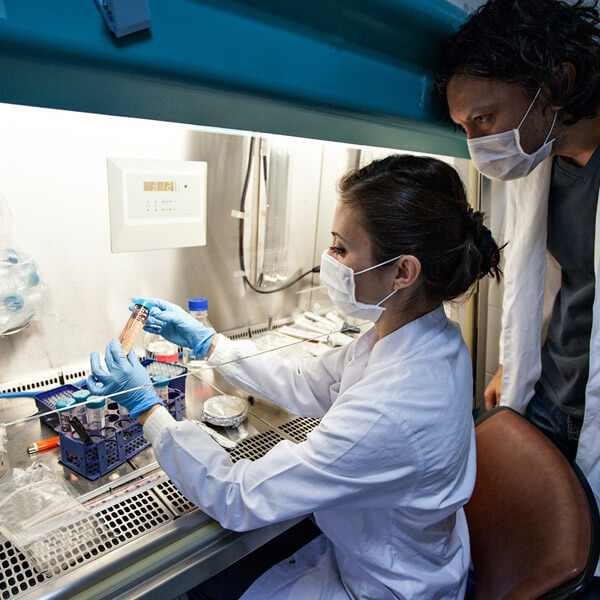Hysterosal Pingogram
Hysterosalpingography in Chicago, IL
Hysterosalpingography at Reproductive Medicine Institute
With over two decades of combined experience, Reproductive Medicine Institute offers the hysterosalpingography procedure to Chicago, IL women wanting to determine their fertility potential. We understand that people are looking for safe and effective evaluations that offer advanced fertility support. Hysterosalpingography (HSG) is a radiography procedure that gives our professionals an up-close look at the condition of a patient’s fallopian tubes or if any blockages are present. Learn more about HSG and what this procedure can do for your reproductive health.

What to Expect
Tubal evaluation can be done in one of two ways. The first involves the injection of X-ray dye into the uterine cavity and fallopian tubes along with imaging using an X-Ray machine (HSG). The second consists of an injection of sterile saline (water) into the uterine cavity and tubes along with imaging using an ultrasound machine (SonoHSG). Both techniques allow our professionals to assess the shape of the uterine cavity as well as the patency of both fallopian tubes. During the procedure, you may experience mild cramping, which can last anywhere from a few minutes to a few hours. Your provider may advise you to take pain medications to use for menstrual cramps shortly before the procedure, and at any time cramping is experienced. This process can be performed in our offices or surgical center and does not typically require anesthesia.
How an HSG Is Done
For an HSG, you will be positioned under an X-Ray imager. One of our experienced team members will then delicately place a sterile speculum into the vagina to assist in the visualization and cleaning of the cervix. A small catheter is then safely placed into the outermost opening of the cervix, where through it, an iodinated liquid is injected through the catheter (iodinated liquid can be visualized on an X-Ray screen). As the fluid enters the uterus and fallopian tubes, we will more accurately be able to assess the shape of your uterine cavity along with the shape and patency of the fallopian tubes. Local anesthesia may be applied for those needing extra support during this procedure. A hysterosalpingography test will only take about five minutes to perform.
What Are the Risks of HSG?
Risks of the HSG may include bleeding, infection, or radiation exposure. Typically, bleeding will last around one to two days after the procedure. If bleeding lasts longer or is heavier than a standard period, contact our staff immediately. The risk for infection is less than one percent, and our team may be able to provide antibiotics before or after the procedure to help safeguard you from this risk. Radiation exposure from an HSG is very low and would not harm a pregnancy if conception were to occur later in the cycle. Pregnancy tests are routinely done before the procedure to ensure the test is not performed during pregnancy.
The Benefits of HSG
When it comes to your fertility, we only offer the best solutions. You can rest easy knowing our team will assess if HSG will benefit you. In many cases, we find that this procedure delivers the favorable results we are looking for on the journey to fertility. There are many benefits to an HSG test, as studies have found that this procedure can notably increase rates of a successful pregnancy. Some of how HSG benefits our patients include:
- The ability to affirm abnormalities in the fallopian tubes and uterus, such as scar tissue and adhesions.
- It allows our doctors to more accurately investigate the overall shape of the fallopian tubes and uterine cavity.
- The flow of the dye that is inserted into the uterus and fallopian tubes during HSG may help to dislodge any blockages.
- If blockages are present, the inserted dye will visibly spill out into the abdominal cavity, giving us a clear image of the blockage site.
What This Test Tells You
Abnormalities with the fallopian tube can be seen in up to a quarter of couples with infertility. These abnormalities can be caused by scar tissue, pelvic inflammatory disease, or other pelvic diseases, such as endometriosis. In addition to diagnosing tubal factor infertility, HSG can be used alongside transvaginal ultrasound to identify developmental uterine anomalies, such as septate, unicornuate, bicornuate, and didelphic uteri. Our specialists understand that when it comes to fertility, you need reliable answers. Our top-of-the-line HSG tests will give us a better look at your unique situation so you can achieve optimal fertility outcomes in our care. We look forward to helping you overcome any obstacles you and your partner may be facing on the road to conception.
Contact Reproductive Medicine Institute Today!
As the largest and most successful fertility centers in the Midwest, we feel confident in our ability to perform safe and reliable fertility examinations when you need them most. We know that this journey isn’t an easy one, and we approach each patient with the utmost compassion and genuine support. Schedule an appointment with us today to receive an HSG test at our Chicago clinic. You won’t regret it!
Have more questions? Speak with an RMI team member.

